Increase Your Energy with
Mineral Balancing
An exceptionally effective, individualized and affordable natural health approach to improve energy, including recovering from deep states of fatigue and burnout!

Mineral Balancing helps guide the way to sustainable energy, as well as to deeply and gently rebuild and detoxify the body with nutrients.
It uses Hair tissue mineral analysis to gain detailed insight into the body's state of mineralization.
Minerals are part of the "building blocks" that make up our bodies. We need them to produce energy, digest properly, create hormones, regenerate tissues, maintain a balanced mood, and all the other functions of our physical and psychological health.


Everyone today has mineral deficiencies. Because modern farming methods exploit and empty the soils instead of nourishing them, we no longer receive from our food enough minerals and vitamins to maintain optimal health, including repairing and regenerating our tissues. Organic food is typically not replenishing enough either.
Even more, all the stresses we experience contribute to the loss of our minerals, and in creating imbalances in the interactions of minerals with each other in our bodies.
Mineral Balancing uses Hair tissue mineral analysis (HTMA) interpreted in a specific way (developed by Dr Paul Eck and Dr David Watts) to identify not only the degree of our mineral deficiencies, but also the specific way in which they are in balance or out of balance (their ratios).
The result is an individualized profile of our biochemical state of the last few months. It helps to clarify an individualized map of nutritional supplements that can help revitalize the body, by continuously guiding our mineral system as close to balance as possible.

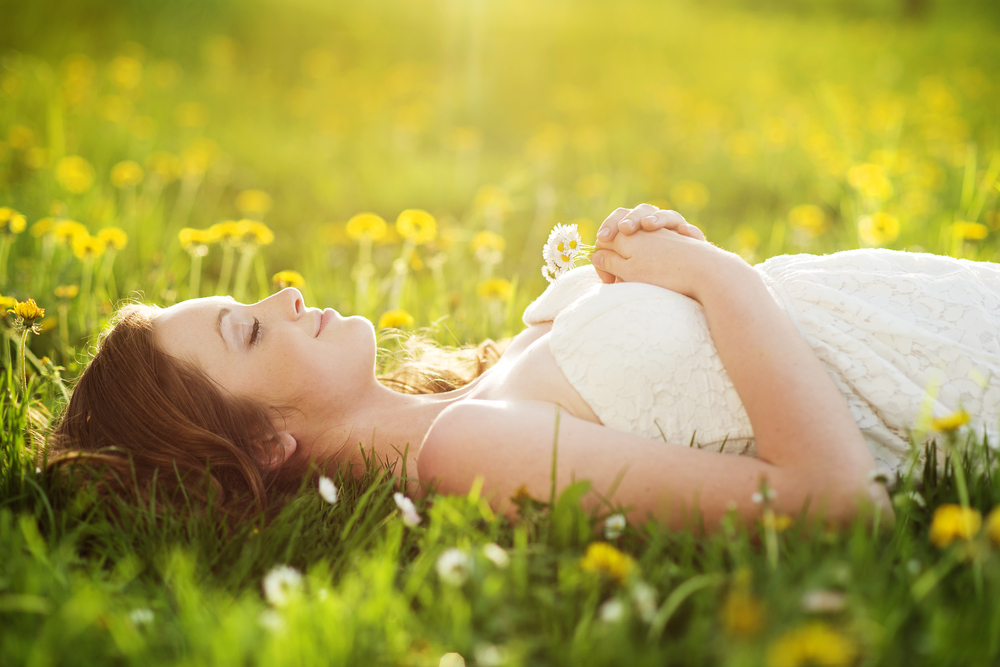
When the mineral system is well supported, energy levels rise (if required) and stabilize, and health imbalances diminish or disappear, without the need to directly address them one by one.
By working directly at the level of the minerals, of some of the "building blocks" that make up our body, we offer it the possibility of transforming right down to the physiological root of persistent fatigue/burnout, for example.
This enables us to generate sustainable energy once again, as well as recreating healthier tissues, and thus a healthier body, better able to cope with stress and the requirements of our demanding lives.
A mountain of information from a single low-cost test
A simple Hair tissue mineral analysis, properly interpreted, can offer you insights into:
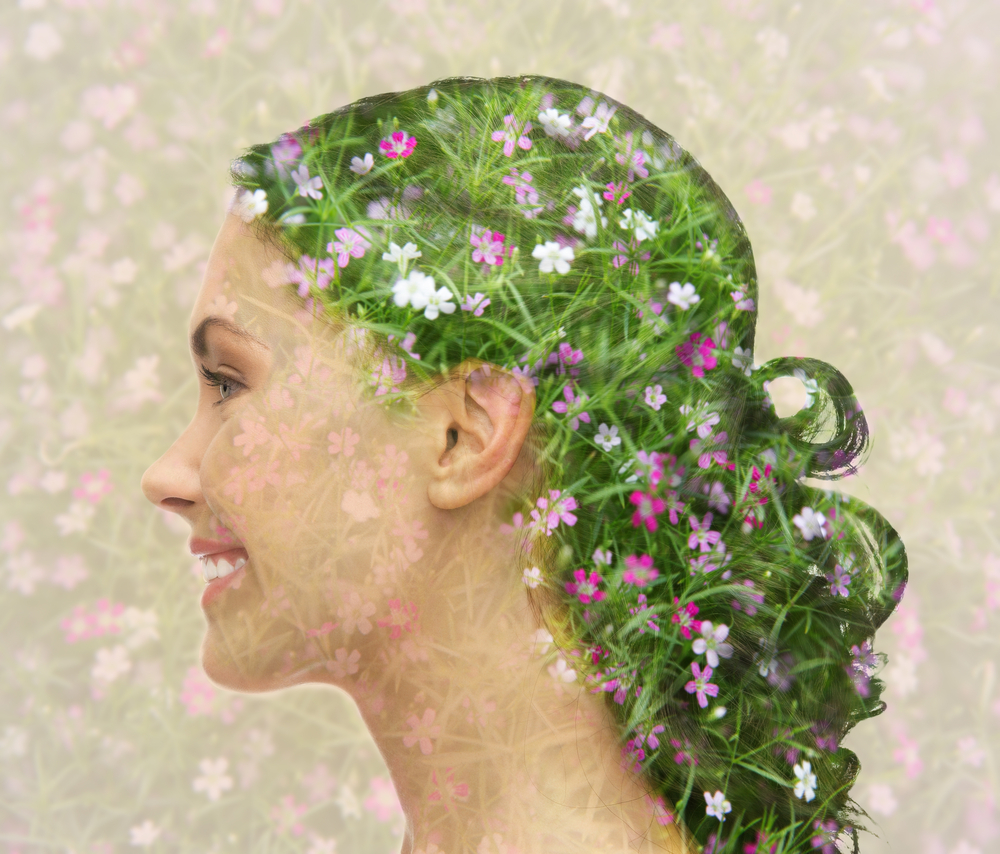
Your cellular energy level
Your type of energy/fatigue (there are many!)
The state of your adrenal function
The state of your thyroid function
The dominant activity of your nervous system
How well your body is nourished (mineralized) at cellular level, or not
Your blood sugar regulation
Your digestion
Your hormonal regulation (including cortisol)
The heavy metals actively eliminated by your hair and/or if your body is too exhausted to eliminate heavy metals
Your detoxification capacity
Certain indications of psychological and emotional health
And much more!
And then, of course, we can take action to rebalance all this: with supplements, diet, lifestyle modifications, etc.
In addition, compared to functional medicine tests such as OAT, GI-MAP, DUTCH, saliva cortisol, etc., an HTMA is much more affordable! See Services & Pricing for details.
For example
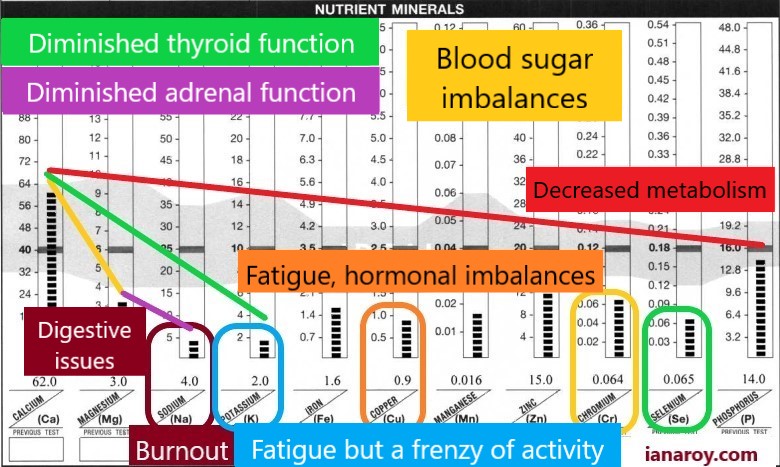
In addition to a tendency for blood sugar imbalances (indicated by, among other things, a high calcium/magnesium ratio and a chromium deficiency), this HTMA chart extract shows several signs of exhaustion:
Decreased metabolism (high calcium/phosphorus ratio)
Diminished thyroid function (high calcium/potassium ratio, selenium deficiency)
Diminished adrenal function (low sodium/magnesium ratio)
Burnout (and digestive issues) (very low sodium level)
Fatigue, along a frenzy of activity (tired but wired) with great difficulty in "doing nothing" which perpetuates exhaustion (very low potassium level)
Fatigue (and hormonal imbalances) (low copper level)
And much more!..
Please note, however, that Hair tissue mineral analysis as interpreted in Mineral Balancing is NOT a diagnostic tool. This test points to trends observed at the cellular level, but of course I will invite you to consult a physician for any diagnosis.
Furthermore, although Mineral Balancing takes health conditions into account, it never treats directly symptoms and illnesses (which is the domain of medicine). Rather, it aims at supporting the body in depth by remineralizing it, and working to bring it and keep it always more in balance at the biochemical level.
Mineral Balancing is great for fatigue
Discover in detail how this approach could help you!
Mineral Balancing works at the cellular level
Because an HTMA offers a perspective on what's going on at the cellular level, in a way that blood testing doesn't, Mineral Balancing is a particularly valuable approach when a person is really not feeling well, but is told "Your labs are normal".
It allows to influence our biochemistry directly in the tissues, toward better mineral levels and balance, and thus a better health.
The primary aim in Mineral Balancing is to bring and maintain the levels of the first 4 minerals (calcium, magnesium, sodium and potassium) as close as possible to the ideal (the dashed horizontal line on this chart from Analytical Research Laboratories).
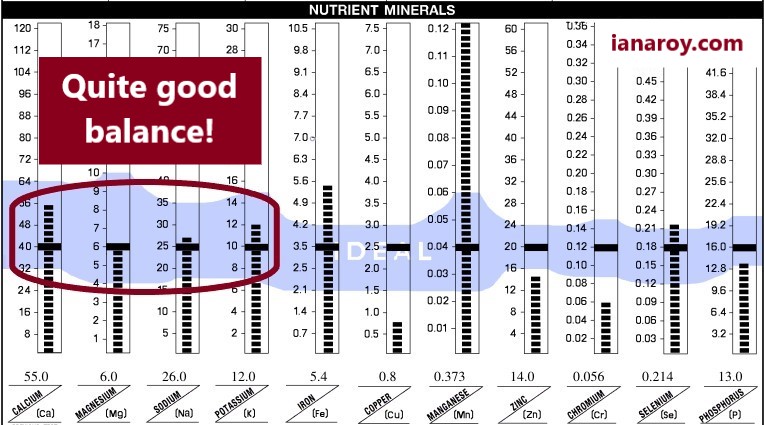
When these 4 electrolyte minerals work together optimally, the body is in a better state of homeostasis (balance). It then generates increased and more stable energy production, and is in a better metabolic position to repair tissues and detoxify (e.g. by eliminating heavy metals).

To bring the levels of the 4 main minerals into balance, Mineral Balancing essentially uses targeted and precise supplementation, individualized according to our current deficiencies and imbalances, taking into account too the rest of the HTMA results.
Changes in diet, stress management and lifestyle are often suggested also (e.g. increasing rest and sleep time), as these elements also influence our mineral pattern.
Mineral ratios are important

3 examples of high ratios on a Trace Elements chart
In Mineral Balancing, not only the levels of minerals count, but also their interactions with each other (their ratios).
When important mineral pairs appear out of balance on an HTMA, disturbances can typically be observed in physical and psychological health.
For example, we can see here (to be assessed by a physician for any diagnosis):
High sodium/potassium (Na/K) ratio
Tendency for inflammation, possibly pain
High calcium/potassium (Ca/K) ratio
Tendency for low thyroid function (associated among other things with fatigue)
High calcium/magnesium (Ca/Mg) ratio
Tendency for blood sugar imbalances
Rebalancing excessively high or low ratios of key minerals on an HTMA gradually improves the body's ability to generate more healthy, sustainable energy, among other benefits.
Individualized solutions for different types of fatigue
Mineral Balancing has been shown to be effective to improve fatigue and burnout (and many other conditions!) since at least the early 1980s. Although it is still a little-known approach, it is no less potent when properly applied.
The results of an HTMA provide a picture of the body's metabolic type and, by extension, its type of fatigue.
Thus allowing to support the body toward greater balance and energy in an individualized and precise way.

4 examples of metabolism types (and fatigue)
as identified in Mineral Balancing
Slow oxidizer

In this mineral pattern, energy production and metabolism are slower than what's preferable. Few indications that can be observed on this chart:
Fatigue (quite low sodium and potassium levels)
Reduced ability to produce energy and adapt to stress (low sodium/potassium ratio)
Diminished thyroid function (high calcium/potassium ratio, low selenium level; also low sodium/potassium ratio)
Diminished adrenal function (low sodium/magnesium ratio)
Parasympathetic dominance of the nervous system (high calcium/phosphorus ratio)
Even if calcium and magnesium levels appear optimal or high, on this mineral pattern part of these levels represent biounavailable amounts. Therefore, calcium and magnesium are not present in excess or optimal amounts in the body. Rather, there is a tendency toward bone loss.
Reduced detoxification capacity due to slow metabolism
Tendency toward these other conditions (to be assessed by a physician for any diagnosis):
Low body temperature
Constipation
Blood sugar imbalances
Lack of stomach acidity
Tendency to gain weight, especially around the hips and thighs
Low blood pressure
Possibility of depressive and/or anxious moods
Preference for reflection, study, introversion, etc., rather than action and active connection with the outside world.
This is a very common mineral pattern.
Slow oxidizer under stress
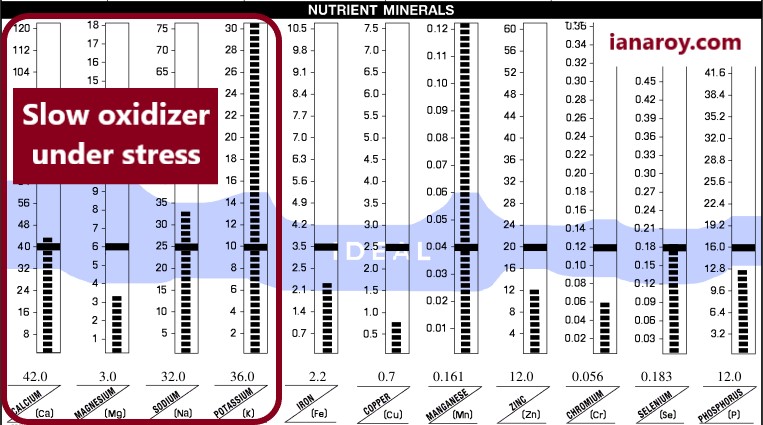
This mineral pattern is typical of a slow oxidizer experiencing stress, which has the effect of raising sodium and potassium levels.
There is more energy produced than in the previous pattern. But this is partly in response to stress (external and/or internal), therefore it's not fully a healthy energy.
The very low sodium/potassium ratio is indicative of a significantly reduced ability to produce energy and adapt to stress
There is a tendency toward these other conditions (to be assessed by a physician for any diagnosis):
Apparent acceleration of thyroid function, when in reality, more profoundly, this function is rather diminished
Reduced immune capacity (including the possibility of allergies)
Bone loss (the body may be drawing on its reserves, including the bone, to generate some of the energy it needs to cope with stress)
Blood sugar imbalances
The sodium and potassium levels of this pattern do not represent their actual cellular retention.
This high potassium level, for example, is indicative of massive excretion of potassium from the cells into the bloodstream, due to stress. As the hair received this high quantity of potassium from the blood and stored it, the laboratory analysis detected a high level of potassium.
So the high level here doesn't indicate the presence of too much potassium in the body. Rather, it is amply eliminated, including through the hair. The person actually needs a significant potassium intake.
This mineral pattern is quite common.
Slow oxidizer under stress with a high sodium/potassium ratio
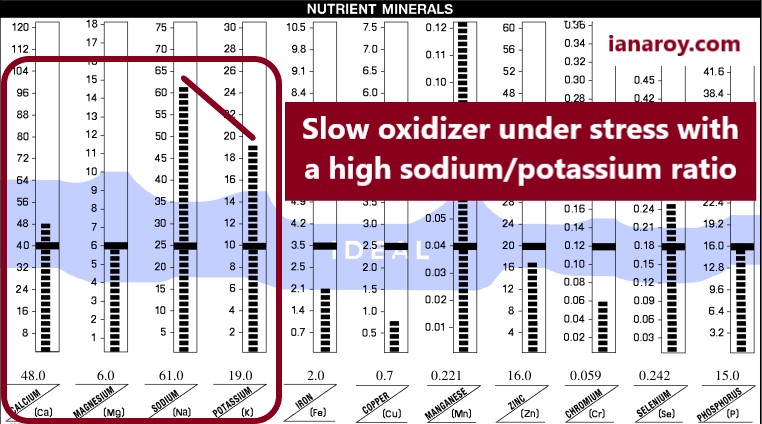
I personally identify this mineral pattern in this particular way (you won't find that name anywhere else). I feel it represents a type of fatigue, albeit less common than the previous examples.
This pattern is similar to the "Slow oxidizer under stress", but this time the sodium/potassium ratio is high, as is (always) the calcium/phosphorus ratio.
Fatigue is more subtle: Thyroid and adrenal functions appear to be more rapid. The person seems to have a lot of energy. But, again, this is not fully a healthy energy production. Energy is partly fueled by stress.
The body does, however, have a quite better resistance to stress and ability to face it and adapt to it, compared to the previous patterns.
There is a tendency toward these other conditions (to be assessed by a physician for any diagnosis):
Inflammation
Bone loss
Possibly emotions such as anger, irritability and aggression
Some Mineral Balancing practitioners would say that this pattern is representative of a healthy fast metabolism. I disagree. To explain it in technical terms, it's the slightly elevated calcium/phosphorus ratio that is here, in my opinion, the main indicative sign of a fundamentally slow metabolism.
When the sodium level is quite high, as in this example, I personally like to call it (again, you won't read that anywhere else) the "Icarus pattern", in reference to the story from Greek mythology, because the person is in a state of apparent high energy, but without the full metabolic resources to generate that energy in a healthy and sustainable way.
In terms of Traditional Chinese Medicine, it seems to me that it also increases the possibility of a Yin deficiency, associated for example with dryness in the body.
I think that this state cannot go on indefinitely, in most cases. A bit like Icarus, who tried to fly very high, to get close to the sun with wings held with wax, if the person doesn't accept to slow down, some kind of fall is likely.
4 Lows

This mineral pattern is called "4 Lows" because the 4 main minerals (calcium, magnesium, sodium and potassium) are all below the optimal level (the dashed horizontal line near the middle of the chart). Of the 4 examples we have seen, this is the pattern associated with the greatest degree of fatigue.
When this pattern is present on an initial test, it typically indicates:
Chronic fatigue that has reached a serious state. It can even be similar to a "hibernation", to protect the body from an energy expenditure it no longer has the metabolic capacity to assume
Chronic undernutrition and significant demineralization, regardless of the quantity of food ingested, quality or otherwise. This condition may be partly explained by struggles in digesting and assimilating nutrients.
Very low detoxification capacity. Typically, this type of pattern is accompanied by very low levels of heavy metal excretion. But this is simply because the body is too exhausted, and its detoxification pathways probably too blocked, to be able to eliminate them.
There is a tendency toward these other conditions (to be assessed by a physician for any diagnosis):
Digestive problems
Possibility of chronic infections
Insomnia
Allergies
Low sex drive
Food and supplement intolerances
Possible bone loss
A feeling of being stuck in one's life, as well as repressed feelings and unresolved traumas, may frequently be present
Tendency to social isolation
Breaking out of this (increasingly common) mineral pattern requires a great deal of remineralization, as well as almost always inner and lifestyle transformations, which can take time.
Unlike most Mineral Balancing practitioners, I personally identify several subtypes within the “4 Lows” pattern. I therefore offer individualized supplementation plans based on these subtypes, which is likely to be especially precise and effective.
My Mineral Balancing supplementation and recommendation programs are designed to guide these 4 mineral patterns (and others!) toward greater balance.
What else can we see on an HTMA?

This chart is indicative of a slow metabolism (including tendency toward diminished thyroid function), as well as blood sugar imbalances, among other elements.
Here's the full result of the "Slow metabolism" example seen in the previous section. In addition to all the characteristics already discussed, a few other trends can be detected (to be assessed by a physician for any diagnosis):
General demineralization predisposing to fatigue
The sub-optimal chromium level contributes to the likely present blood sugar imbalances (essentially associated to the high calcium/magnesium ratio)
The low selenium level plays a role in the tendency toward low thyroid function (essentially associated to the high calcium/potassium ratio) and suggests as well reduced capacities of detoxification.
Heavy metals (especially lead, mercury and aluminium) are actively eliminated in this person's hair. This may be due to detoxification of metals that were present in the tissues and/or recent exposure to these metals in the diet and/or the environment:
- Lead is a highly toxic metal that is not usually easily detoxified. As this is a slow oxidizer pattern, with reduced detoxification capacities, it is possible that this lead comes from recent exposure – for example, that the water supply in the home runs through lead-soldered pipes.

- Elevated levels of mercury (another highly toxic metal) are frequently seen in the results of people who regularly eat large fish (tuna, sushi...) or sometimes in those with dental amalgams ("silver" fillings). High levels of mercury in the body can, for example, weaken thyroid function.
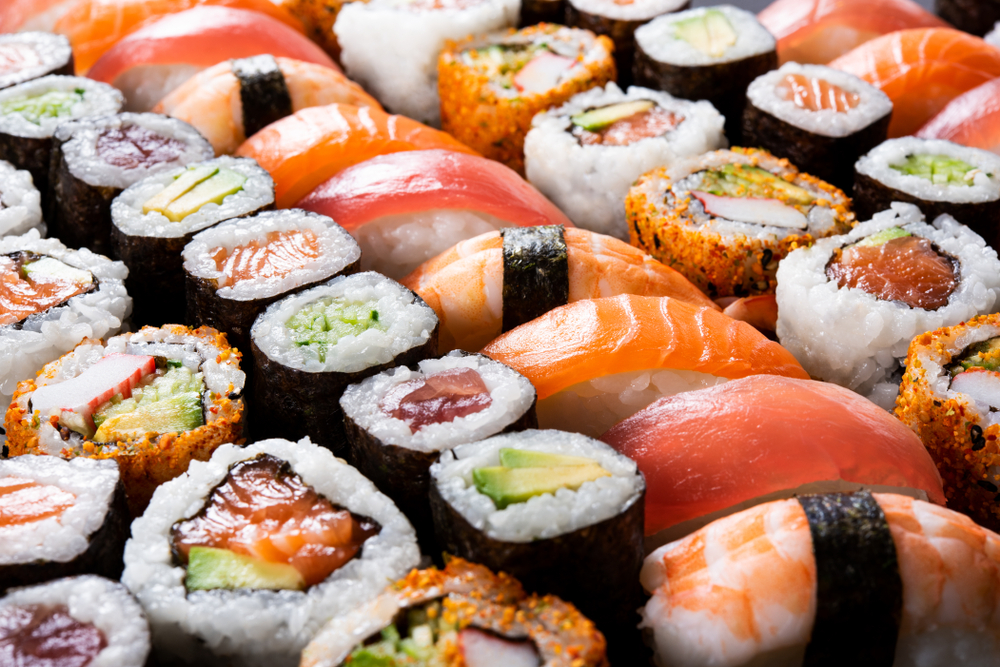
- Elimination of aluminium is common in HTMA results, as this metal is very present in our environment, and the body seems to excrete it through the hair more easily than other metals.
High levels of aluminium in the body affect the nervous system and brain, and can be associated, for example, with cognitive loss.

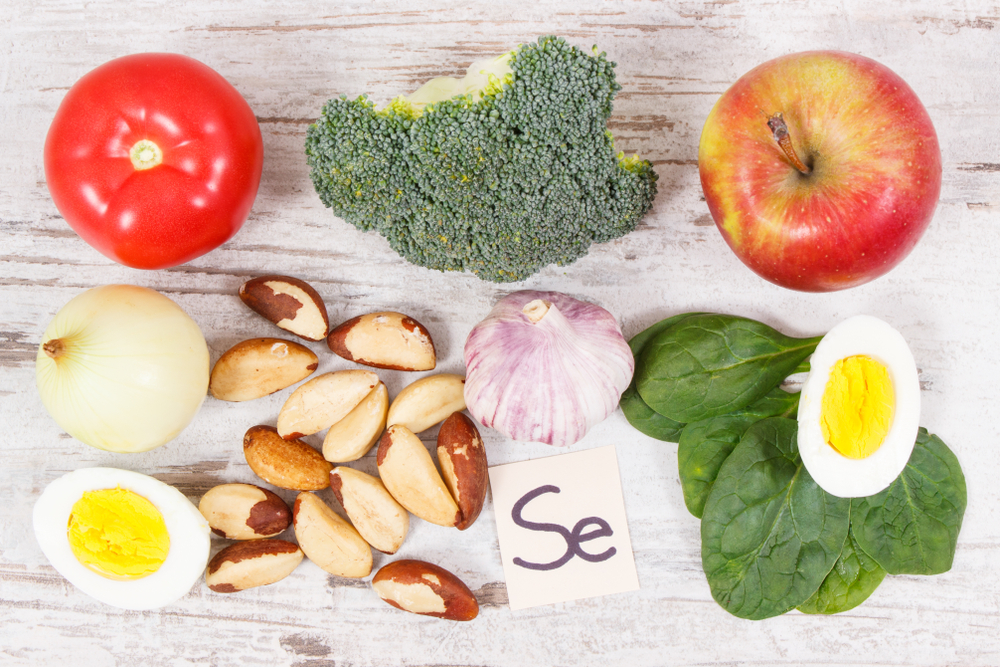
Gentle detoxification of heavy metals
Unlike chelation and other aggressive protocols used in some approaches, in Mineral Balancing we detoxify heavy metals:
By deeply nourishing the body
By increasing its metabolism – the body needs to have energy to be able to eliminate well heavy metals
By working toward the best possible balance of the 4 main minerals
By ensuring that the body's detoxification pathways are well supported, by (among other things) including a supply of minerals that promote detoxification capacities
And, mostly, by providing the body with minerals that can replace heavy metals lodged in the tissues.

This rather good balance of the 4 main minerals creates favorable metabolic conditions to the simultaneous elimination of biounavailable iron, manganese (toxic form) and aluminium. These are often eliminated together, hence their nickname of the "3 Amigos".
This is because, in Mineral Balancing, the body is considered to preferentially use certain minerals to function optimally. When its preferred mineral for a function is not present, the body, in its intelligence, will use another element that resembles it – even if it's a heavy metal.

For example, cadmium (a heavy metal) has atomic characteristics similar to zinc (an important mineral). We can see here that they are neighbors in the periodic table of the elements.
If the body doesn't get enough zinc through diet and/or supplementation, it can replace it with cadmium for certain functions. Even if this is not ideal, at least the body is able to ensure a certain level of functioning.
If the body subsequently receives sufficient zinc, and is in appropriate metabolic conditions, it will naturally tend to replace cadmium in the tissues with zinc, leading it to be able to detoxify cadmium.
Many Mineral Balancing practitioners have observed this process again and again clinically in people who have followed appropriate long-term supplementation programs.
With this approach, detoxification of heavy metals hidden in tissues takes place gently and gradually, at the pace the body chooses.
You can learn more about this gentle detoxification approach called BRET (Biological Replacement of Elements Theory) in this article by my main Mineral Balancing teacher, John Bumpus.

Chronic fatigue is often associated with a dysregulation of copper metabolism
One of the key reasons behind the burnout and/or persistent fatigue of many women (and an increasing number of men too) is a chronic dysregulation of their body's copper metabolism.

Copper is an important mineral for health, and most people today are deficient in it. At the same time, as the body becomes fatigued and less and less able to produce and circulate bile (a liquid from the liver), it begins to accumulate copper, especially in the liver and the brain, in a way that is not bioavailable (usable) by the body.
A paradox then arises: although the body needs bioavailable copper for its day-to-day functions, copper is stored in tissues without the body being able to use it. So there is a combined state of deficiency and excess, in different parts of the body.
Accumulation in the liver, brain and other organs and tissues over time perpetuates profound fatigue and other physical and psychological health problems of all kinds. It's a very common mineral imbalance, often closely associated with advanced states of fatigue.
A very low level of bioavailable copper, like the one on this result, is a fairly reliable indicator that there is in fact a lot of biounavailable copper stored in the tissues, although this is not yet visible on this HTMA chart.
If the body is adequately supported, it will eventually tend to be in a better metabolic position to detoxify the stored copper. The copper level might then appear high on HTMA results, a sign that biounavailable copper is being excreted by the body, including in the hair.
Depending on the body's initial state (including the degree of fatigue), this process can take months or years.

Some conditions associated with a chronic dysregulation of copper metabolism
(To be assessed by a physician for any diagnosis)
Exhaustion/chronic fatigue
Premature grey hair
Liver and/or gallbladder problems
Hypothyroidism
Constipation
Gynecological problems such as cysts, fibroids, endometriosis
Infertility
Insomnia

Racing mind
Great creativity
Mind that likes to float in intellectual/spiritual spheres outside of concrete life
Difficulty concentrating
Dyslexia
Obsessive thoughts
EMF sensitivity
Eating disorders (anorexia, bulimia, orthorexia, etc.)
Chocolate cravings
Hypoglycemia
Yeast infections (candida)
Anemia, especially when it doesn't improve by taking iron
Caring a lot (for others, animals, the environment, etc.)
Hypersensitivity, tendency to cry easily
Anxiety
Panic attacks
Depression
Cyclothymia/bipolar disorder
Hopelessness, suicidal thoughts
Main factors predisposing to accumulation of biounavailable copper in the body
Use of the contraceptive pill, copper IUD or other forms of hormonal contraception and/or hormonal therapy involving estrogen (estrogen and copper have a close relationship)
Drinking or having regularly drunk water that has circulated through copper pipes
Vegetarian/vegan diet
Transmission of copper from mother to child via the placenta – more and more children are being born with excess copper.
Mineral Balancing is a powerful and precise approach for restoring balance in copper metabolism in the long run.
HTMA results must be interpreted beyond appearances
Perhaps you are beginning to see that Hair tissue mineral analysis results, as interpreted in Mineral Balancing, can't be read as they appear.
Mineral levels showing on the chart do not necessarily represent actual tissue levels
Often, the level of a mineral appears low or high without this being representative of the actual cellular level. These important interpretative subtleties require in-depth training and experience.

A low level (of iron, for example) does not necessarily mean that there is a lack of iron in the blood and that large quantities of iron must be supplemented. Iron metabolism is complex.
Likewise, a high level (of calcium, for example) doesn't automatically mean that there is an excess of this mineral in the body, and that its intake should be avoided through diet or supplementation.
As we have seen, the HTMA calcium level may often appear higher than optimal because this mineral is in fact biounavailable in the body. This means that it will tend to accumulate in soft tissues (such as hair) and joints, while at the same time being deficient where the body truly needs it, in bones and teeth.
So, in such a case, avoiding calcium is not a good idea. While supporting the general metabolism, it will be important to supplement calcium, but in the company of "allied" nutrients that will enable it to go into the bones and teeth, rather than the soft tissues and joints.

A very high calcium level (known as a "Calcium shell") frequently appears in the HTMA results of people living with severe chronic fatigue, joint pain, fibromyalgia and/or depressed mood states (to be assessed by a physician for any diagnosis). People may also feel as if their emotional state is "frozen", making it difficult for them to access and feel their emotions.
With appropriate supplementation, and other recommendations, this "shell" can be broken, often resulting in increased metabolism and energy, as well as psychological changes.
Minerals work together in a complex system of interactions
The difficulty of interpreting mineral levels has led many scientists to doubt the value of HTMA in assessing the body's state of mineralization.
It was truly the extensive theoretical and clinical research work of Dr. Paul Eck and Dr. David Watts (in the USA, mainly in the 1970s-1980s) that shed light on the immense value of HTMA data when interpreted in a specific way.
Dr. Eck and Dr. Watts realized that the mineral levels in HTMA results do not represent the exact state of their cellular reserves, as if they were reservoirs to be filled.

And that it's not as simple, for example, as taking lots of salt to raise the sodium level, or potassium-rich foods to raise the potassium level.
The two researchers found that, in fact, supplementing a low mineral level with that mineral can result in a drop in that mineral's level on the next HTMA.
Intrigued, Dr. Eck and Dr. Watts went on to conduct thousands of hair analyses, comparing results with the supplementation taken by their clients. They discovered that supplementing one mineral (or vitamin) has an impact on the HTMA levels of other minerals.
They realized that nutrients interact together in a dynamic system (a bit like a community, I would say). And that they have complex relationships with each other.
Some examples of nutrient interactions
Taking zinc and/or vitamin C decreases the copper level
Taking a significant amount of magnesium typically lowers the sodium level
Copper, vitamin D and vitamin B12 all contribute to raise calcium and lower potassium levels.

Supplementing with minerals and vitamins therefore affects not only our mineral reserves, but also the relationship of minerals to each other, toward more balance or imbalance.
This is why blind supplementation is not the optimal method for replenishing our reserves and ensuring the best possible balance. By thinking we're doing the right thing, we can in fact frequently cause new imbalances, even more in the medium to long term.
Dr. Eck and Dr. Watts have discovered that taking into account the complex interactions between minerals, especially the pattern of the first 4 minerals, is the key to accurate interpretation of HTMA results. It's also what helps guide the choice of effective supplementation to rebalance body biochemistry.
Mineral Balancing allows for individualized supplementation
Therefore, the mineral pattern is not only different for each individual, but also dynamic. It changes according to our diet, our supplementation, our lifestyle, our sources of stress, and so on.
From this point of view, we can see that taking large quantities of minerals and vitamins is an interesting initiative, but for optimal health, it's even better to supplement certain nutrients specifically according to our own needs at one time, in order to try to always keep our mineral system as close to balance as possible.

According to the Mineral Balancing approach, it's obvious that premade general mineral and vitamin protocols with fixed dosages may not suit everyone. Or, may suit a person at one time, and then no longer.
Indeed, these protocols can potentially create major imbalances in individuals if the needs of their mineral pattern do not, or no longer, correspond to these protocols.
Supplementation based on HTMA results is not as simple as it seems

Even today, for many reasons, Mineral Balancing remains a little-known approach, and many natural health practitioners continue to interpret HTMA results assuming that the levels represent the actual amount found in the cells.
This usually leads them to suggest to their clients to supplement minerals whose levels appear low, and to avoid taking minerals whose levels appear high.
From a Mineral Balancing perspective, this way of supplementing without taking into account the deep dynamics at work in the mineral system is not only inappropriate, but can actually worsen a person's condition if their mineral pattern becomes even more out of balance with that supplementation.
Interpreted in a Mineral Balancing way, HTMA data offers a "map" of supplementation recommendations that is far more precise, individualized and therefore, usually, also far more effective.

An in-depth, long lasting and affordable approach

Although we can often see some changes taking place fairly quickly, Mineral Balancing is essentially a "slowly but surely" type of approach, especially for very devitalized bodies. I like to explain it by saying that the more depleted and demineralized the body is, the more it resembles a "gravel ground". To turn it into a fertile, flourishing garden, with lots of minerals in balance, it takes time.
Although Mineral Balancing is the best tool I know of for deeply restoring healthy energy production, depending on the initial state of the body, lasting energy improvement can take several months to take hold, and even a few years for advanced states of chronic fatigue. According to this approach, it's unrealistic to expect that physical and/or psychological health imbalances that may have been present for decades can be completely resolved in a matter of weeks or even months. If you're looking for a quick fix, Mineral Balancing is not the way to go.
Moreover, improvement does not occur in a continuous, straight upward curve. Different cycles operate, generating a recovery with highs but also certain moments of integration for the body, and even some lows, which are part of the long-term process.
But the beauty, the power and the great gift of Mineral Balancing is that this approach doesn't just target superficial or temporary improvements. It enables deep-rooted restoration of the body's terrain. It is likely to be useful even when many other health approaches have failed.
HTMA after HTMA, we can often see how the body is remineralizing and, gradually, eliminating heavy metals. How it tries to find a new balance, removing one by one the layers of compensation it has built up over the years to adapt to unhealthy conditions.


Constantly nourished, biochemically reequilibrated and remineralized as much as possible, the body creates conditions conducive to cellular regeneration. It carries out the physical and psychological transformations it needs, in the order that suits it, at its own pace.
Although we may try to steer the results in a particular direction, ultimately it's the Vital Life force which, through the body's innate wisdom, decides on the order of restructuring to be brought to the body, and so, on how the improvement in physical and psychological health will take place.
To be able to restore this body's inner state in depth, Mineral Balancing therefore requires a certain perseverance. And also the motivation to take supplements several times a day, and, if necessary, to make dietary and lifestyle changes.
But it's so worth it. As we've seen, a low-cost HTMA (see Services & Pricing) provides an enormous amount of information that can be used to work on many levels at once:
Energy
Adrenal function
Thyroid function
Nervous system
Digestion
Blood sugar regulation
Hormones
Detoxification
Elimination of toxic metals, etc.
All in one non-invasive test you can do at home. You simply fill in my online questionnaire, collect your hair sample and send it to a laboratory, which will email me your chart results. You'll then receive my report explaining the key points observed in your test, as well as, if that's what you've chosen, a personalized supplementation program and other recommendations for you!
I can adjust the list of recommended supplements to fit a limited budget. Some of my suggestions for improving health are free or affordable. I can also recommend only a few supplements if you don't want to take many.
However, to get the best results, I ideally recommend a budget of at least CA$125-160/month in supplements. Less than that will bring benefits, but you should also expect a probably slower rate of improvement.
Keep in mind that thanks to Mineral Balancing's ability to accurately identify the most relevant supplements, we typically see much more results than when supplementing blindly, so it's usually a fruitful investment.

I can work with you in complete respect of your preferred diet. For best results, for most people I generally recommend an omnivorous diet, adding supplements as needed to help better digest animal products. But of course, it's your decision.
It's worth mentioning that as our mineral pattern is fluid and changing, a supplementation plan aimed at rebalancing HTMA results cannot be followed for too long without checking its impact on the mineral system. In the long term, this could lead to further imbalances.
To maintain an optimal rate of improvement, it is therefore important to adjust supplementation according to new results. Doing 3 to 4 HTMAs/year is typical and offers a fairly accurate and affordable picture. Fewer HTMAs will yield certain results, but it should be anticipated that sooner or later the supplementation plan will no longer be adapted to the new state of the mineral system.
When we have more energy, life's horizons broaden!

Restoring energy is a long-term investment that profits all aspects of our lives!
Our relationships, professional and leisure activities, ability to experience moments of pleasure and a fulfilling sex life (and other areas!) all benefit.
I am highly trained in Mineral Balancing

As you can see, interpreting HTMA results is complex. I absolutely suggest working with a practitioner with extensive training and/or experience in Mineral Balancing, or taking a high-quality course yourself, but not supplementing from HTMA results without proper training. All too often, this leads to a worsening of the situation.
It's important to know that there's not only one way to practice Mineral Balancing. Within the method itself, there are several schools of thought. Not all practitioners interpret results in the same way, and not all use the same protocols or supplements. These different angles and protocols produce very variable results.
Also, there is no single training path. You can come across very short courses, or completed without skills assessment, or focused on using databases that provide automated recommendations without the need of a deep understanding of that system.
I've been interested in Mineral Balancing since 2016, and began studying it in depth in 2018, for my own recovery. I took my time. I have been slowly deepening my understanding of this method and experimented it so as to improve my own health first, and also be able to master it adequately before offering guidance to others.
I love to learn and deepen my knowledge constantly. I studied extensively the different camps, until I was certified in the most comprehensive and advanced course in the world, with whom I consider to be the best researcher in Mineral Balancing, my teacher John Bumpus.
I am now highly qualified in advanced interpretation of HTMA charts. I've become John's assistant at Mineral Balancing Academy to help him fine-tune his training so that it can eventually be offered again. I am also currently the world's most highly trained francophone in Mineral Balancing.
Over the years, I've generated my own synthesis, mainly from John's angle, but also including what I've learned from Dr Rick Malter, then Kendra Perry, as well as public material from the many other practitioners whose work I've come across, plus my own experiments, and even little personal contributions that I am starting to share more widely.
My approach is gentle, respectful of the body and deeply nourishing.
In addition to minerals and vitamins, I also include as needed in my practice some herbs, as well as cell salts, whose deficiencies I have learned to identify through facial analysis (I also offer this type of analysis).

Although my specialty is energy regeneration in cases of fatigue/burnout, as a certified Mineral Balancing practitioner I'm able to offer supplementation recommendations for any HTMA done by laboratories that don't wash the hair sample before analyzing it: Analytical Research Laboratories (ARL), Trace Elements, Inc (TEI), CanAlt and Lifeline Diag. My current preference is to use ARL and, in some specific cases, TEI.
If you would like my presence and support
on your remineralization and natural health journey,
It will be my pleasure to offer you guidance with heart, expertise and authenticity.
In their words...

Iana Roy is my assistant at Mineral Balancing Academy and has played a huge role behind the scenes to help fine-tune the Mineral Balancing course for practitioners in preparation. She is well versed in advanced topics of Mineral Balancing and Hair tissue mineral analysis. With her interest in holistic health, Iana can provide insight and guidance for many different domains of our reality.
John Bumpus
BHS, hTMAP, SNTR
Practitioner, teacher and researcher in Mineral Balancing
His website is an excellent resource for learning more about Mineral Balancing

Iana Roy excelled in learning the fundamental concepts and principles related to properly interpreting and applying HTMA data to optimize individual supplement protocols to help people to rebalance their vital mineral system.
FAQ
Does taking the hair sample leave a visible hole in the hairstyle?
If the hair sample is correctly taken, no! The best way to do this is to cut small strands at various points on the nape of the neck and/or in the area of the middle back of the head, underneath the top hair, thus keeping the small gaps hidden.
Can I do an HTMA if my hair is dyed?
Ideally, it's definitely best to wait 4 to 8 weeks for natural color regrowth. It's a good idea to take a hair sample just before dying you hair again, for example. If it's not possible to wait, please wash the hair at least 10 times after treatment before taking the sample, and be sure to indicate it in the questionnaire to be sent back to me, mentioning, if you know it, the hair color brand.
Why do we need to take supplements? Is it possible to remineralize from food alone?

It would be great if food were enough to restore our mineral levels and ratios!.. However, in my experience, it's largely insufficient, especially for people with chronic health conditions.
In my opinion, soils have been so depleted by decades of intensive farming that food alone can no longer optimally remineralize our bodies.
So food first, yes; but I suggest adding supplementation absolutely. The difference in the depth and speed of improvement can be enormous.
However, if you really prefer to use only food and food-based supplements, I can adjust to that request.
Where can I learn more about Mineral Balancing?
The best resources aren't easy to find. The founders of Mineral Balancing published very little about their work. Today, it's mainly the practitioners of this approach who discuss it on their websites, and who have set up courses.
It's important to remember that there is no uniformity in Mineral Balancing. Practitioners are trained differently, unevenly, and don't all work in the same way, or with the same products. So you may come across all kinds of information on the Internet, which may not represent at all what I do myself. As reliable starting points, I suggest:
MineralBalancing.org, the site of my main teacher, John Bumpus
The eBook Energy: How it affects your emotions, your level of achievement, and your entire well-being (also called: Energy – An Interview With Paul Eck), available on Amazon
This free pdf file contains a long extract published in 1981 by The Healthview Newsletter (no longer in existence).
If you like what you read, I suggest you buy the full eBook!
Dr. David Watts' book, Trace Elements & Other Essential Nutrients: Clinical Application of Tissue Mineral Analysis. The best price I know of for the new book is offered on this page of the TEI laboratory website. There is also an "Educational Resources" section on this site, where you can read for free some content written by Dr. Watts.
Dr Rick Malter's book, The Strands of Health: A Guide to Understanding Hair Mineral Analysis, available on Amazon
. Dr Malter has also a blog on his website where you can read articles for free.
CopperToxic.com is a good resource for understanding the implications of chronic dysregulation of copper metabolism.
The Mineral Balancing community is quite present on social media, Facebook and Instagram especially. You can find various groups and pages discussing it. Remember, once again, that practitioners don't work all in the same way.
If you'd like to know more, drop me a line! I'll send you more ideas for resources to consult according to your specific needs.
Wishing you a joyful and delicious health!
😊

